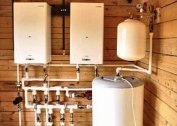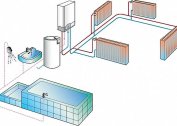A feature and the most attractive quality of underfloor heating is the warm air that rises from the bottom up, creating a feeling of comfort. When using such a system, moisture, mold and bacteria will not accumulate under the floor covering, as the environment will become unfavorable for their existence. It should also be noted that laminate and parquet are not the best flooring for this kind of flooring. Therefore, if you buy them, it is only with a special note that they are suitable for the installation of underfloor heating.
Heating systems are divided into electric and water.
Electric cable floors
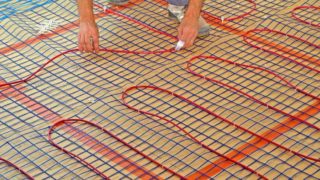 The basis of such a warm floor is a single-core or two-core cable. To create comfortable conditions in residential premises, it is recommended to use a two-core system. To determine which warm floor is better, just look at the features.
The basis of such a warm floor is a single-core or two-core cable. To create comfortable conditions in residential premises, it is recommended to use a two-core system. To determine which warm floor is better, just look at the features.
The difference lies in the installation method, in which for a single-core analogue it is required to provide for the return of the wire to the starting point. At the same time, a two-core cable is safer, easier to install, more durable, but more expensive by 20-30%.
Safety in the operation of electric underfloor heating is achieved through 2 layers of insulation. Then, in most cases, the wires are protected by a metal braid and an outer sheath of polyvinyl chloride. The metal braid is a shield against electromagnetic radiation.
The disadvantage of installing electric cable underfloor heating is the need to make a cement screed. The design looks like this:
- On the basis of the floor insulation is laid;
- Heat-reflecting elements such as foil;
- The bottom layer of concrete-sand screed;
- Cable;
- Top concrete-sand screed;
- Decorative coating.
It should be noted that such a design can increase the height of the floor by 8-12cm. It is also recommended to add special plasticizers to the screed to increase its elasticity and thermal conductivity.
Inconvenience
The main problem is that from the moment of installing a warm floor to the start of its operation it should take almost a month for the screed to dry completely. Otherwise, cracks may form along the screed.
The choice of warm floors directly depends on the totality of some indicators: whether it will be the main heating of the room or additional, what type of flooring will be used.
Electric cable floors do not fit well with parquet and carpet, as These materials are sensitive to high temperatures. Nevertheless, their use is possible if the underfloor heating does not have a capacity of more than 110W per sq.m. In this case, the generated heat will be enough to have pleasant heat underfoot, but other types of heating will need to be warmed up.
The heat from the cables can cause wood to dry.
Thermomats
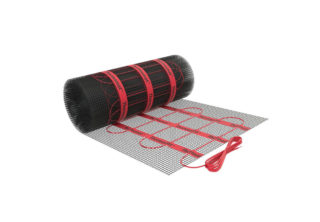 This type of heating device is perfect for a bathroom and kitchen with a decorative tile cover. This is a self-adhesive fiberglass mesh divided into segments with an already fixed cable, where the main heating element is carbon rods.
This type of heating device is perfect for a bathroom and kitchen with a decorative tile cover. This is a self-adhesive fiberglass mesh divided into segments with an already fixed cable, where the main heating element is carbon rods.
Thermomats have several significant advantages:
- No screed is required for installation. The grid with cables is laid on the base of the floor and fixed with glue for the tile, which is immediately laid;
- Extra segments can be cut off from the whole mat along special lines. In this case, the cable is not damaged;
- The height of the floor does not change. The device is located in the thickness of the glue and does not add centimeters.This is especially important if there is no way to raise the floor or wait for the screed to dry;
- No need to lay the cable yourself, as it is already fixed.
The disadvantages include the fact that thermomats, as well as cable devices, are not the best option for installation under a carpet, parquet or laminate.
Film underfloor heating
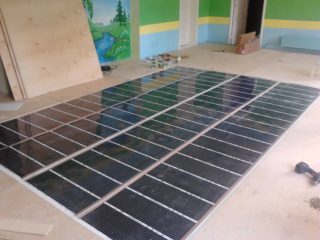 For comfortable heating, a heating film is considered the best option. It fits into all types of flooring. But it should be noted that for parquet power should not exceed 110 watts. per sq.m., while under ceramic tiles you can purchase a film with a power of up to 220 watts. per sq.m.
For comfortable heating, a heating film is considered the best option. It fits into all types of flooring. But it should be noted that for parquet power should not exceed 110 watts. per sq.m., while under ceramic tiles you can purchase a film with a power of up to 220 watts. per sq.m.
But low power does not adversely affect furniture and heat-sensitive flooring, for which it is recommended to set the maximum temperature threshold to 27C.
Such a warm floor consists of a polyester film, between two layers of which two plates are placed in the segments: an aluminum alloy and a copper alloy. Through the wire, electricity is supplied to the plates and processed into heat.
Among such heating devices, infrared films are considered the best. They are divided into the same segments, but filled with slightly different elements. Through an alloy of copper and silver, current is supplied to a carbon paste, which exceeds the heat transfer indicators of other analogues.
The advantages of film heating include a minimum material thickness of 3mm to 8mm. Given the thin layer of the heat insulator, raising the floor level will be no more than 1 cm, often raising is 0.6 cm. Such heating systems can be attached to walls and even to the ceiling.
Also, many film systems are characterized by efficiency, because the heating temperature can be set different for each room, and the film itself saves about 20% of the energy consumed in comparison with cable underfloor heating.
In addition, the installation does not require a large expenditure of time and money. The film simply spreads over the surface and closes with a floor covering. If necessary, the film is easily removed and reinstalled in a new place.
The disadvantages of film underfloor heating include a short life. On average, it is 15 years, but subject to operating conditions, it can work for a longer time.
Temperature sensors
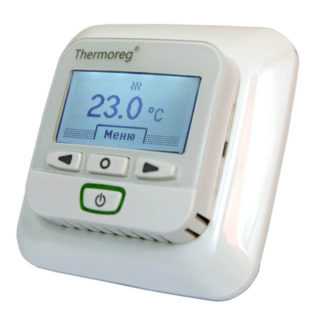 Monitoring of the heating temperature is carried out using temperature sensors, which differ significantly in their functionality.
Monitoring of the heating temperature is carried out using temperature sensors, which differ significantly in their functionality.
The simplest model when the temperature is regulated by a wheel. In this case, the floor will warm up evenly at the set temperature until new changes are adjusted.
An improved option is an automatic sensor. On a small LCD screen, the air temperature in the room is set. As soon as the temperature rises to the indicated level, the heating is turned off, and after a little cooling is turned on again.
And the most modern model is programmable. The sensor indicates the time the system is turned on and off for a certain period of time with a certain temperature. So the whole week the system will automatically lower or raise the heating temperature at night, or turn off the heating at a time when nobody is usually at home.
Water heated floors
 This type of heating is carried out by circulating hot water under the floor. Pipes, through which water circulates directly, are connected to a heating plant or to an autonomous heating system in a private house. This system is economical because it is enough to warm the water to a maximum of 50C so that the temperature above the floor is 30C
This type of heating is carried out by circulating hot water under the floor. Pipes, through which water circulates directly, are connected to a heating plant or to an autonomous heating system in a private house. This system is economical because it is enough to warm the water to a maximum of 50C so that the temperature above the floor is 30C
The installation scheme of water heated floors is as follows:
- Insulation is laid on the floor base (polystyrene is often recommended);
- On top of a double snake or snail pipes are laid;
- It is poured with a concrete-sand screed with plasticizers;
- Mounted flooring.
It should be borne in mind that the floor level rises by 7-12 cm.
The pipes themselves can be made of different materials - copper, metal plastic, polyethylene, etc. However, pipes made of polymers, which include polyethylene, are considered the most practical.
Copper acts as a good heat conductor, but quite expensive, and when laying pipes made of metal-plastic when the product is bent, damage to the inner aluminum layer is possible, which will eventually lead to leakage.
But subject to the installation technology, all materials showed good performance and the choice of the best warm floor is made taking into account the advice of specialists specifically for a particular type of housing and, of course, financial opportunities.
The temperature of a water heated floor can be regulated, but more difficult than electric and this requires the installation of special parts. For each circuit, water flow regulators are mounted, and on the return manifolds - thermal valves. With the help of these devices, the volume of water supplied is regulated, and it is also possible to partially or completely shut off the circuits.
If the underfloor heating comes as additional heating to the radiator, then to save money, you can artificially lower the water temperature to 45 C. For this, circulation pumps and valves are mounted. The pump constantly pumps water through the pipes, and the valve periodically passes part of the hot water into the pipes, maintaining the set temperature.
If the building is old and may not be able to withstand an additional layer of concrete, then instead of concrete-sand screed, special polystyrene plates can be used. In this case, the pipes fit into the grooves previously provided in the plates.
The advantages of such a warm floor include its efficiency during operation. Also, such a system does not dry the air and can be located under the furniture.
However, water heated floors are difficult to make in an apartment, because special permission is required to connect to the central water supply system, and in the conditions of communal apartments there may not even be enough water. Therefore, such systems are most often installed in country houses with an autonomous heating system.
Installation is also not cheap, but this drawback pays off with low consumption of funds for heating in the future.
